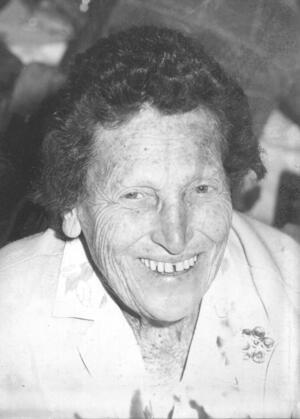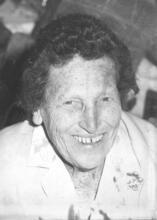Tikvah Alper
Tikvah Alper.
Courtesy of Michael Sterne/Wikimedia Commons.
Tikvah Alper was born in South Africa in 1909 to Russian refugees. As a gifted young student, she was awarded a grant to study at Cape Town University, where she earned her master’s degree in 1929. As a doctoral student in Berlin, Alper was mentored by the famous physicist Lise Meitner. With the rise of Nazism in 1933, Alper returned to South Africa, where she married a bacteriologist. As a married woman, she could not be appointed to any academic position, so she worked together with her husband in a small private laboratory in their home. She later lost her position at the National Physics Laboratory in 1951 because of her opposition to apartheid. Her most famous work occurred at London’s Hammersmith Hospital, where she worked her way up from unpaid researcher in 1951 to director of the Radiopathy Unit from 1962 to 1973. During this time, Alper discovered that diseases like scrapie and mad cow replicated without DNA, challenging our modern understanding of disease.
Early Life and Accomplishments
Tikvah Alper was an outstanding radiobiologist who had to overcome many obstacles in her personal and professional life.
The youngest of four daughters in a family of refugees from Russia, she was born in Wynberg, South Africa on January 22, 1909. She was educated at Durban Girls High School, where she took the final examination when she was only fifteen years old. Thanks to her scholastic achievements she received a grant to study mathematics and physics at Cape Town University. In 1929 she received her M.A. and was awarded the Porter Scholarship for further studies in Berlin.
From October 1930 until the winter of 1932–1933, Tikvah Alper was a doctoral student in the Kaiser Wilhelm Institute for Chemistry in Berlin-Dahlem in the department headed by Lise Meitner. Here she studied delta rays from alpha particles, publishing the initial results of her research in the Zeitschrift fuer Physik (Journal of Physics) in 1932. The paper won her the British Association Junior Medal in 1933.
Research Work in South Africa
Because of the situation in Germany after January 1933, Tikvah Alper returned to South Africa. She married a bacteriologist, Dr. Max Sterne (1906–1994), but never changed her name. Since, as a married woman, she could not be appointed to any academic position, she worked together with her husband in a small private laboratory in the garden of their home. Her son Jonathan was born in 1935, followed the next year by her second son, Michael. Tikvah Alper managed the household and cared for the children, learning speech therapy in order to care for Jonathan, who was born deaf. She also pursued her scientific interests and research. Later she was appointed a lecturer in physics at Witwatersrand University.
In the winter of 1946–1947, Tikvah Alper accompanied her husband to Great Britain, where he was a visiting scholar. Here she was able to restart her scientific career, first as an unpaid research fellow in the Gray Laboratory of the Hammersmith Hospital in London, then in the team of Douglas Lea in Cambridge, where she worked on the irradiation of bacteriophage. On returning to South Africa, Tikvah Alper was appointed head of the Biophysics Section in the newly created National Physics Laboratory—a position she lost in 1951 as a result of her opposition to apartheid. In the same year the family left South Africa to settle in Great Britain.
Radiopathology Research in Great Britain
Starting her scientific career once again, she first received a small grant at the MRC Experimental Radiopathology Research Unit at Hammersmith Hospital in London. Here she developed a remarkable career, first as an unpaid researcher, then with a small grant, finally becoming a staff member in 1953. In 1962 she was appointed director of the unit. She retired from this post in 1973 and from 1974 until 1977 worked as Senior Advisor at the Gray Laboratory. In 1979 she published her important book Cellular Radiobiology. She died on February 2, 1995, in Salisbury (Hampshire).
Research Legacy
Tikvah Alper became world-famous during the “mad cow disease” epidemic, first diagnosed in 1986 in Great Britain. Already in 1960 she had published a letter on structures of viruses in the journal Nature, together with Mort Elkind and Neil Gillies. With her husband Max she had irradiated the scrapie virus, which became important in the 1990s. Tikvah Alper had a great influence on several generations of radiobiologists not only in Britain but internationally. Her London home in Philbeach Gardens was a center of communication and meetings between scientists, colleagues and friends from all over the world. She never forgot her first teacher Lise Meitner or her fate, but unlike Meitner, she referred to herself as a lifelong feminist. Until she was in her late 80s she liked to sail, to travel and discover worlds hitherto unknown to her.
Alper, Tikvah. Cellular Radiobiology. Cambridge: 1979.
Obituaries
Alper, Tikvah. “A Passion for Science.” Obituary by Shirley Hornsey. Guardian, February 22, 1995.
Fowler, Jack. “In memoriam Tikvah Alper 1909–1995.” In Radiation Research, April 1995, 142 (1): 110–112.
Hornsey, S. and J. Denekamp. “Tikvah Alper: An Indomitable Spirit, 22.1.1909–2.2.1995.” In International Journal of Radiation Biology, vol. 71, No. 6 (1997): 632–bibliography on pp. 638–642.
Sources
Archive KWG/MPG Berlin: I, 11, Nr.351 (lists of staff members, KWI for Chemistry, October 1930–February 1932); III, Rep.14 B. (letter Lise Meitner to Otto Hahn, 6.4.1930).
Churchill College Archives, Cambridge, Lise Meitner papers (letter Tikvah Alper to Lise Meitner, 1946; Lise Meitner to Otto Robert Frisch, 6.9.1956.)
Literature
Sime, Ruth Lewin. Lise Meitner: A Life in Physics. Berkeley, CA: 1996, 406 and 429.
Vogt, Annette. Women Scientists in Kaiser Wilhelm Institutes, from A to Z (Dictionary). Berlin: 1999, 19–20.




